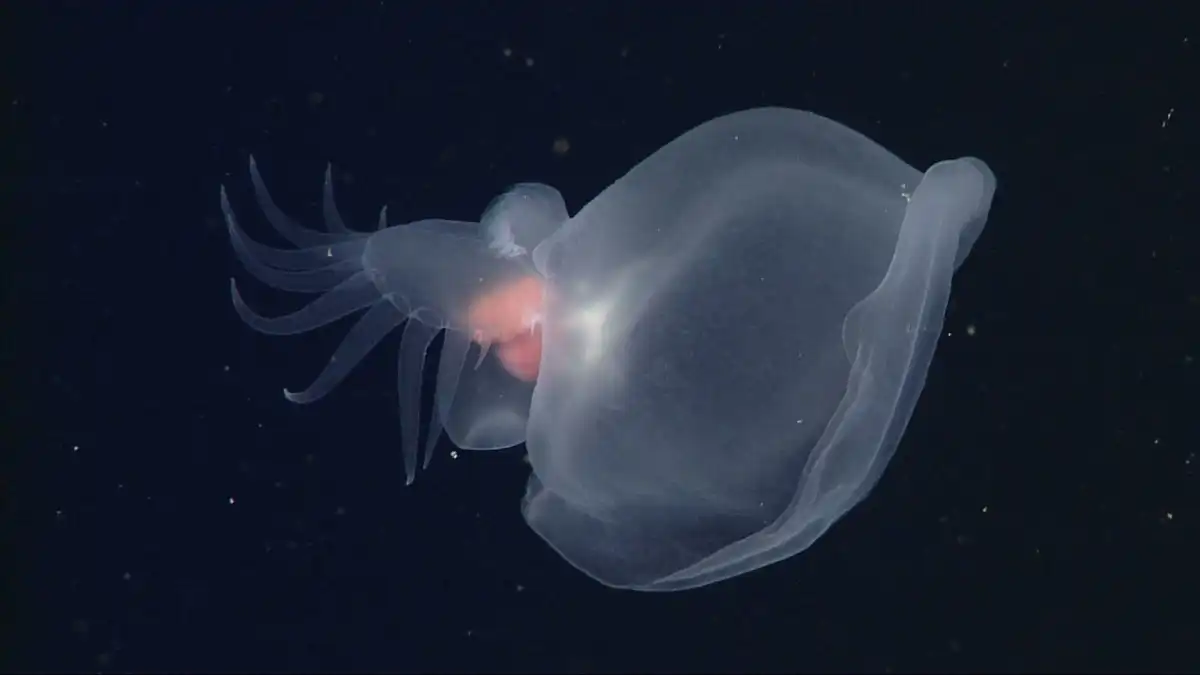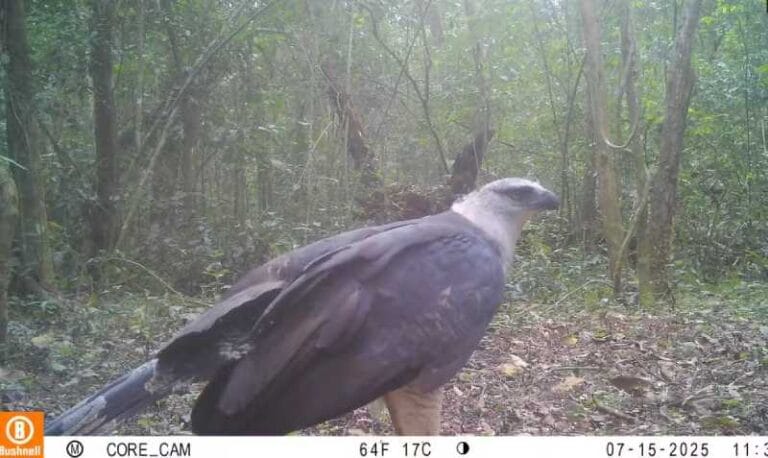Scientists discover a new species of sea slug

Researchers have identified a surprising new species in the ocean’s midnight zone: a luminous sea slug named Bathydevius caudactylus.
Roughly the size of an apple, this glowing mollusk defies expectations for its kind. Although classified as a sea slug, Bathydevius differs greatly from the typical slugs observed by scientists at the Monterey Bay Aquarium Research Institute (MBARI).
Unlike its shallow-water relatives, Bathydevius is a free-swimming sea slug adapted to life in the deep ocean, a region stretching between 3,300 feet (1,000 meters) and 13,100 feet (4,000 meters) below the surface. With its bioluminescent glow, paddle-like tail, and large gelatinous hood, it’s the first sea slug discovered to inhabit the open waters of the deep ocean. Most sea slugs reside on the seafloor or in coastal environments, such as tide pools, with only a handful living near the surface in open water.
Senior MBARI scientists Bruce Robison and Steven Haddock first encountered this enigmatic species in February 2000 during a deep-sea dive near Monterey Bay using the remotely operated vehicle Tiburon. Since that initial sighting, researchers have observed Bathydevius over 150 times, cementing its status as a “mystery mollusk.”
The adaptations of Bathydevius are uniquely suited to the midnight zone, the largest habitat on Earth, encompassing 70% of the planet’s seawater. The extreme depths and lack of sunlight in this region make it one of the least understood environments. Studying Bathydevius could shed light on the remarkable survival strategies of creatures thriving in this dark, pressurized ecosystem.
“We’ve invested more than 20 years in understanding the natural history of this fascinating species of nudibranch,” said co-lead study author Robison. “Our discovery is a new piece of the puzzle that can help better understand the largest habitat on Earth.”
At first glance, Bathydevius caudactylus “looks more like a megaphone with a feathered tail than a sea slug,” said co-lead study author Steven Haddock.
This unusual marine animal features a massive, bowl-shaped hood at one end and a flat, feather-like tail fringed with fingerlike projections at the other. Between these striking structures, its colorful internal organs are visible, adding to its otherworldly appearance. It also has a snail-like foot, which initially puzzled researchers about its classification within the mollusk family.
MBARI’s underwater research robot has observed Bathydevius in the deep waters off the Pacific Coast of North America, from Oregon to Southern California. Additionally, similar creatures have been sighted in the Mariana Trench, located in the Western Pacific, by researchers from the National Oceanic and Atmospheric Administration. These sightings suggest that Bathydevius may have a wider range than previously thought.
To better understand this mysterious sea slug, the team collected a specimen for detailed analysis in the lab. Anatomical and genetic studies confirmed it to be a nudibranch—a type of soft-bodied marine gastropod—but one with extraordinary adaptations. These features equip Bathydevius to capture prey and thrive in the midnight zone, a realm of perpetual darkness and crushing pressure.
“The deep water column is maybe the last place you’d expect to find a nudibranch,” Robison said. “It’s sort of like finding hummingbirds near the peak of Mt. Everest. The midnight zone is cold and dark and very forbidding to us terrestrial creatures, yet it is filled with life, albeit life forms adapted to a very different set of challenges than we face. Almost every aspect of Bathydevius reflects an adaptation to this habitat: anatomy, physiology, reproduction, feeding, behavior; it’s unique.”
The name Bathydevius caudactylus reflects the species’ unique characteristics and the challenges it posed to researchers. “Bathydevius” highlights its “devious” nature in initially misleading scientists, while “caudactylus” refers to the dactyls, or fingerlike projections, on its tail.
Unlike typical sea slugs, which use a raspy tongue to scrape prey from the seafloor, Bathydevius employs a more sophisticated hunting method. Its large hood acts as a trap, allowing it to capture fast-moving crustaceans like mysid shrimp with precision.
“When animals transition from living on the seafloor to drifting in the water column, they often become larger, more transparent, and more fragile,” explained Haddock. For predators like Bathydevius, catching hard-bodied, quick prey such as shrimp requires an evolutionary advantage—similar to how jellyfish use stinging cells to immobilize their meals.
“For this nudibranch and some other deep-sea animals, they engulf their prey,” Haddock said. “Instead of being stronger than their dinner, their flexibility absorbs the struggling movements and smothers them as if with a wet blanket.”
Bathydevius is adept at navigating the water column, moving up and down by flexing its body or drifting with the currents.
As hermaphrodites, these mysterious mollusks possess both male and female reproductive organs. When it’s time to lay eggs, Bathydevius descends and uses its foot to temporarily attach to the seafloor.
To avoid predators, Bathydevius relies on its transparent body to blend seamlessly into its surroundings. If threatened, it can quickly close its large hood, propelling itself backward in a rapid escape.
Additionally, Bathydevius can use bioluminescence to distract predators. The luminous granules in its tissues create a “starry” effect across its back, further enhancing its ability to evade danger.
In one remarkable observation, researchers witnessed Bathydevius detach a glowing, finger-like projection from its tail as a decoy to distract a predator. This behavior is similar to how some lizards shed their tails to escape threats. Like these lizards, Bathydevius has the ability to regenerate its dactyls, ensuring it can continue using this clever defense mechanism.
“When we first filmed it glowing with the ROV, everyone in the control room let out a loud ‘Oooooh!’ at the same time. We were all enchanted by the sight,” Haddock said. “Only recently have cameras become capable of filming bioluminescence in high-resolution and in full color. MBARI is one of the only places in the world where we have taken this new technology into the deep ocean, allowing us to study the luminous behavior of deep-sea animals in their natural habitat.”
Bioluminescence is rare among sea slugs, but it is a common trait among roughly three-quarters of the animals living in the water column, according to Haddock. This ability to produce light is a widespread adaptation in many deep-sea creatures, helping them survive in the dark, high-pressure environment.
“This species is the third time that this special ability has arisen in a nudibranch, and that raises many basic questions,” he said. “We don’t yet know the chemicals it uses to make light, what genes are involved, and how this trait could have arisen, seemingly out of nowhere, in this animal. It doesn’t have close relatives among other snails, so it really is a distinct evolutionary event.”
Deep-sea mining, which involves extracting materials from the seafloor, could pose a significant threat to Bathydevius, according to Robison. The mining process stirs up clouds of sediment that obscure the water, potentially disrupting the delicate environment where Bathydevius thrives. Miners pump the extracted material to the surface, separate the minerals, and then release water and sediment back into the water column, further polluting the habitat and potentially harming these unique creatures.
The ability of Bathydevius to spawn on the seafloor while living and feeding in the water column could be jeopardized if deep-sea mining and similar practices continue. This underscores the importance of further research into the creatures inhabiting the midnight zone, as understanding their behaviors and adaptations is crucial for their conservation, the study authors emphasized.
“Deep-sea animals capture the imagination. These are our neighbors that share our blue planet,” Robison said. “Each new discovery is an opportunity to raise awareness about the deep sea and inspire the public to protect the amazing animals and environments found deep beneath the surface.”
A detailed description of this new species was published Tuesday in the journal Deep Sea Research Part I.






